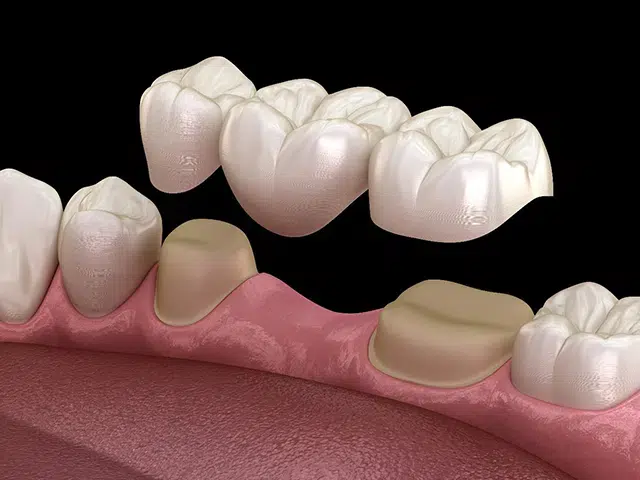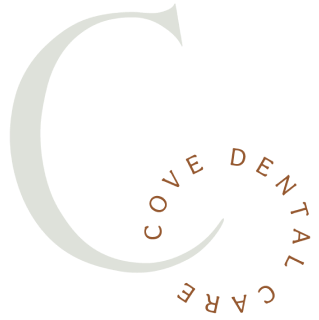105 Sheringham Dr Easley, SC 29642

Bridging Gaps, Restoring Smiles in Easley, SC
When a person experiences severe damage or loss of a tooth, it can significantly impact their quality of life. Beyond affecting their smile's appearance, they may endure low self-esteem, discomfort while eating or speaking, and compromised oral health. If you find yourself in this situation, the caring dental professionals at Cove Dental Care are here to help. Offering tooth replacement solutions like porcelain dental bridges, we can assist you in restoring both the health and beauty of your smile within a welcoming and expert environment. Before scheduling a consultation with Dr. Carraway and our dental team in Easley, SC, here's what you should know about porcelain bridges.
What Is a Dental Bridge?
A dental bridge is a permanent solution for replacing missing teeth, comprising artificial teeth supported by dental crowns or implants. It serves to restore both function and appearance, preventing adjacent teeth from shifting while improving bite and speech. The process of getting a dental bridge usually requires two or more appointments, involving tooth preparation, custom bridge fabrication, and final cementation to ensure a secure fit.
Why Would I Need a Dental Bridge?
A dental bridge may be recommended if you have one or more missing teeth, as missing teeth can lead to several issues, such as:
Difficulty chewing and speaking:
Missing teeth may hinder proper chewing of food and clear speech.
Shifting of adjacent teeth:
The absence of a tooth can lead to adjacent teeth shifting, potentially causing bite issues and making oral hygiene more challenging.
Gum disease and tooth decay:
Spaces between teeth can serve as areas where bacteria accumulate, leading to the development of gum disease and tooth decay.
Changes in facial structure:
The loss of teeth can lead to alterations in facial structure, potentially resulting in an aged appearance.
A dental bridge serves to restore both the functionality and aesthetics of your teeth. It aids in improving your ability to bite and speak, maintains the alignment of adjacent teeth, and distributes bite forces evenly to prevent excessive wear and tear.
Your dentist can help you determine if a dental bridge is the right treatment option for you based on your specific needs and oral health status.
The History of Dental Bridges
The historical journey of dental bridges is a captivating narrative that unfolds across centuries, showcasing the evolution of dental care and the pursuit of restoring oral health and beauty. From ancient societies to contemporary breakthroughs, dental bridges have served as pivotal solutions for addressing the voids caused by missing teeth. This exploration delves into the historical continuum of dental bridges, chronicling their inception, progressions, and enduring importance within the realm of dentistry.
Ancient Beginnings
The origins of dental bridges can be traced back to ancient civilizations that valued the restoration of dental function and aesthetics. Archaeological evidence indicates that early societies, such as the Etruscans in ancient Italy, pioneered methods for replacing missing teeth. Utilizing materials like human or animal teeth bound together with gold bands, they developed primitive dental bridges to address tooth loss.
Egyptian Ingenuity
In ancient Egypt, the quest for dental restoration persisted. Historical findings reveal that Egyptians employed diverse materials for tooth replacement, ranging from ivory and seashells to precious metals. These early endeavors contributed to the emergence of the concept of dental bridges, although their techniques were rudimentary by contemporary standards.
Advancements in Ancient Rome
During the Roman Empire, dental practices continued to evolve. Aulus Cornelius Celsus, a Roman physician, recorded techniques for tooth replacement in his medical texts. These methods entailed affixing replacement teeth to neighboring teeth using gold wire. Though not as advanced as modern techniques, these methods represented a notable advancement in tooth replacement practices at the time.
A Renaissance of Knowledge
During the Middle Ages, advancements in dentistry were limited, but the Renaissance era sparked a revival of scientific inquiry. Ambroise Paré, a French surgeon, played a pivotal role in advancing dental bridge development. Paré's writings explored tooth extraction techniques and the utilization of artificial teeth crafted from materials such as ivory.
Revolutionary 18th and 19th Centuries
During the 18th and 19th centuries, significant strides were made in the field of dental care. Pierre Fauchard, often hailed as the "Father of Modern Dentistry," pioneered the concept of dental prosthetics, laying the groundwork for the development of modern dental bridges. In the early 19th century, Claudius Ash, a dentist based in London, played a key role in popularizing porcelain dentures and bridges. These porcelain bridges represented a notable advancement in terms of aesthetics and durability compared to earlier materials.
The Advent of Modern Dentistry
In the late 19th and early 20th centuries, dentistry underwent a significant transformation characterized by the introduction of novel materials and techniques. The advent of dental alloys and advancements in adhesive methods enhanced the stability and aesthetic appeal of dental bridges. Innovations such as the casting technique and precision attachments played pivotal roles in refining the fabrication and placement of dental bridges, contributing to their effectiveness and longevity.
Contemporary Innovations
In the latter half of the 20th century, dentistry underwent significant technological advancements. The introduction of dental implants revolutionized tooth replacement, presenting an alternative to traditional bridges. Dental implants offered a stable foundation for individual crowns or bridges, reducing the reliance on neighboring teeth for support and providing a more durable and long-lasting solution.
Materials and Techniques
Contemporary dental bridges are crafted from a range of materials tailored to meet individual patient needs and preferences. Porcelain-fused-to-metal (PFM) bridges blend the aesthetic appeal of porcelain with the durability of metal, offering a balance between strength and appearance. All-ceramic bridges, devoid of metal, provide a natural look and are particularly favored for visible areas. Furthermore, innovations in digital imaging and computer-aided design and manufacturing (CAD/CAM) have enhanced the precision and efficiency of custom bridge fabrication.
The Enduring Significance
Dental bridges remain pivotal in restorative dentistry, providing a reliable solution for replacing missing teeth, restoring oral function, and improving aesthetics. By facilitating comfortable chewing and clear speech, dental bridges play a crucial role in maintaining overall oral health. Moreover, they contribute to the preservation of neighboring teeth alignment and help prevent bone loss in the jaw.
Conclusion
The evolution of dental bridges mirrors humanity's relentless pursuit of innovation and better oral health. From ancient civilizations to modern advancements, dental bridges have adapted alongside improvements in materials, techniques, and technology. Their enduring relevance underscores their importance as a cornerstone of restorative dentistry. With each smile restored, dental bridges perpetuate the legacy of innovation, bridging gaps and revitalizing countless smiles, shaping the landscape of dentistry for generations to come.

